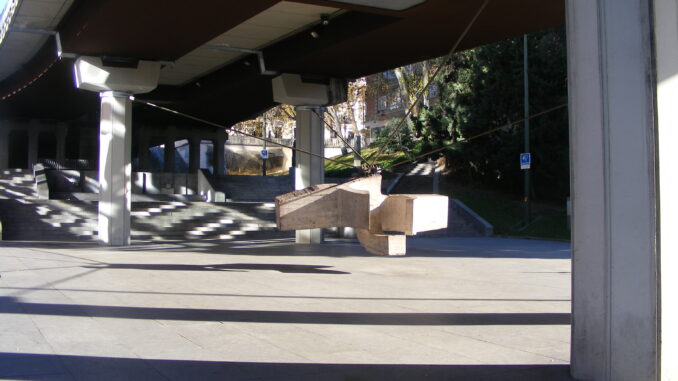
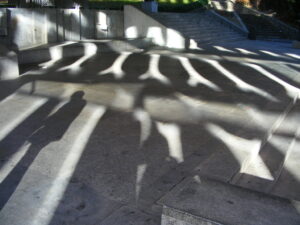
Beneath the flyover which joins Juan Bravo and Eduardo Dato street, to the north of the city centre, is an open air sculpture museum; a retrospective of sculpture from the 1930’s to the current millennium with 17 sculptures by 17 different Spanish artists. The Brutalist bridge of cut steel and white cement that flies over the Paseo della Castellana, originally conceived in 1968, casts shadows in the winter light that make it an ideal location for the contemplation of Spanish abstract sculpture on winter walks.
There certainly was a unique and distinctive abstract sculptural movement in Spain; a love affair with light and shadow, with the dissolving boundaries between materiality and immateriality as bronze or steel cuts the air. But I don’t think all of the sculptures in Madrid’s Open Air Museum deserve to share flyover space with Julio Gonzalez.
Some of the sculptures are grubby and greasy with the endless touch of curious hands, they rattle and rock as if they were not made to weather. Andreu Alfaro’s ‘Un Mon per a Infants’ fans out in a beautiful feathered shape but touch the cheap steel and the illusion is broken. They seem made by sculptors who had only the aesthete’s eye in mind and not his power to touch. They are silhouettes but not shadows. They are not kinetic, they do not have the energy for it.
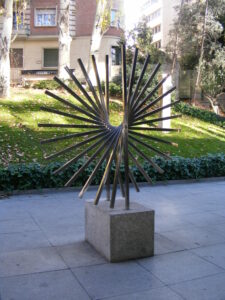
It is Picasso, Gonzalez and Miro’s tangible lust for their materials that makes their sculptures so exciting. You can imagine them wrestling and grappling with metals in a passionate frenzy, sparks flying as they weld and contort. An occupation of sweat and blood, not sketches in the studio. Alberto Sanchez’s ‘Toros Ibericos’ and Marcel Marti’s ‘Proali’ (1984) are the best examples of Spain’s sculptural legacy in deep, rich bronzed browns. Heavy forms whose surfaces will oxidise with the beauty of colours changing in autumn.
There will always be highs and lows, and there is pleasure to be found in the rhythm this gives to a walk of the museum.
Eduardo Chillida offers a focal point. Almost like rays of light emanating from the underside of the bridge, his concrete mobile hangs. It was originally nicknamed the ‘stranded mermaid’. Opened under the careful eye of the Franco regime, the authorities refused to suspend Chillida’s six tons of concrete under the bridge and left it stranded on the floor, its mermaid’s tail flicking in the air it longed to occupy. But a beached whale has no elegance, and it is clear that Chillida’s sculpture gains its lightness from its suspension.

Philosophising on his practice, Eduardo Chillida wrote, “My whole Work is a journey of discovery in Space. Space is the liveliest of all, the one that surrounds us.’ The sculpture here is suspended in space, and if we choose to cheekily climb into its concrete grip, it suspends us in space too.
My friend Natalie, who has come along under duress, circles each sculpture in her red hat and navy coat, subjecting every one to the scrutiny of her close orbit. But her baffled attentiveness is necessary, for the sculptures dance and metamorphose with the slow turn of the viewer.
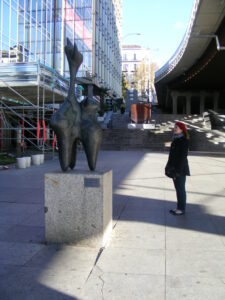
There is always a slight grey chill in constructions conceived under the brutalist eye of the sixties and seventies; bleak high rises and concrete car parks. You have to have been fed on a very particular aesthetic diet not to catch that chill in general, but under a bright winter sunlight and with the right sustenance you can’t fail to be captivated by Madrid’s open air sculpture museum.
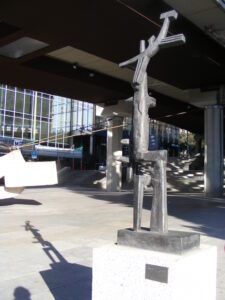

Very mature writing displaying a love for and an affinity with the sculpture form and the urban landscape of Madrid.
Don’t leave us Fran we love you so.
Congratulation for the article.
I enjoyed the tunes and the taste of this colourful description.
[WORDPRESS HASHCASH] The poster sent us ‘0 which is not a hashcash value.